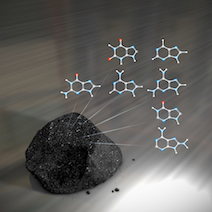Researchers at NASA have uncovered new evidence that DNA components found in meteorites were probably created in space.
Dr. Michael Callahan of NASA’s Goddard Space Flight Center, Greenbelt, Md. and colleagues closely analyzed samples from 12 different carbon-rich meteorites, 9 of which were recovered from Antarctica. They used a liquid chromatograph to isolate a mixture of compounds, which they further analyzed with a mass spectrometer to determine their chemical structure.

The team found adenine and guanine, two of the four building blocks of DNA called nucleobases, as well as hypoxanthine and xanthine. They also found a variety of nucleobase analogs (they have the same core molecule as nucleobases but with a structure added or removed), including three that are rarely found on Earth.
These nucleobase analogs are the first piece of evidence that the compounds came from space and not terrestrial contamination. The team also analyzed samples of ice from Antarctica, where the meteorites were found, and observed significantly different amounts of the two nucleobases. Moreover, none of the nucleobase analogs were found in the ice, showing once again that the compounds probably came from space. The team finally found that these nucleobases are produced in completely non-biological chemical reactions containing hydrogen cyanide, ammonia, and water: this provides a plausible mechanism for their synthesis in asteroids, supporting the idea that they are of extraterrestrial origin.
Here is a short video that gives an overview of the exciting discovery:

This discovery adds to a growing body of evidence that the building blocks of essential biological molecules may actually originate in space, and may raise new questions about the dawn of life on our planet Earth, and possibly eslsewhere in the Universe.


